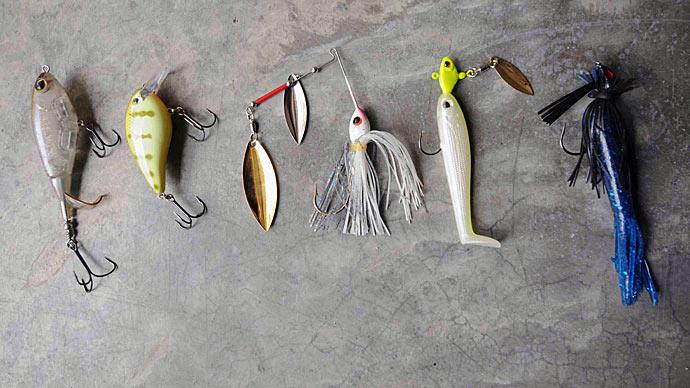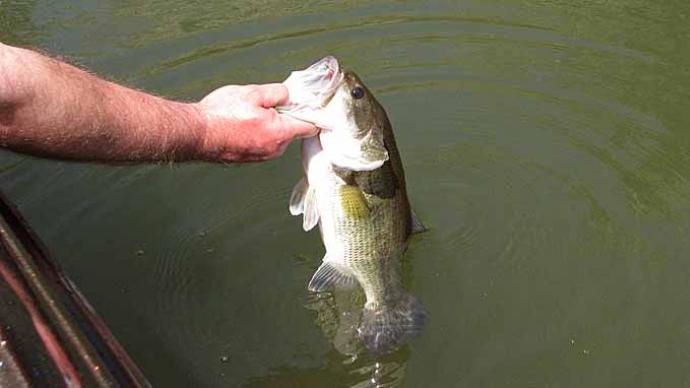
Fall is a season of change. Water temperatures are dropping from the shorter days, leaves are falling off the trees, and football is in the air. I'm not thinking of the pigskin footballs though I'm thinking of football size bass at this time of the season.
Bass are starting to get ready for the upcoming season's changes by putting on the feed bag and moving deeper to wait out the winter months. They well know that change is happening all around them.
So how are you going to chase fall time bass in your waters this season? I have put together my Top Six Fall baits that I depend on fishing with this upcoming fall season.
Spinnerbait
In the fall, it's all about covering water, and a spinnerbait allows you to do just that - cover water looking for bites. If I ever need an idea where the bass are located, the number one bait that I'll grab year-round is a spinnerbait. I can vary my retrieve speed to keep my bait up in the top 2ft of water or slow it down to get it to come through the bottom 2ft of water.
One of the biggest keys when picking a fall-time spinnerbait is to make sure that you're fishing smaller profile spinnerbaits. Lure Parts Online has two perfect spinnerbaits that fall into this category, with the Bill Lowen Compact Spinnerbait, and when you need to reach a little bit of deeper water, I'll use an LPO Hidden Head spinnerbait. Both are compact spinnerbaits that will match the size of the forage at this time of the season in most waters.
Blade configuration will be essential. If you have bass that are buried up, holding on the weed flats, you will need an Indiana or Colorado blade combination to get the bass to come up and meet your bait. I'll use the 3/8oz Bill Lowen Compact spinnerbait for this pattern. I will vary my blade size to have more calling power or get my bait just a little deeper into the water column. Match this with a skirt and trailer of the forage that you're trying to imitate in your waters, and you'll be set.
I'll upsize to a 1/2oz Hidden Head spinnerbait targeting deep-water weeds. I'll arm this with a double willow bade combination as willow blades don't have as much lift as Colorado blades, so I can keep this spinnerbait deeper than I can a bait that has Colorado blades. My goal is to count my bait down and bring it back, contacting the deeper weed tops I'm fishing.
Traps
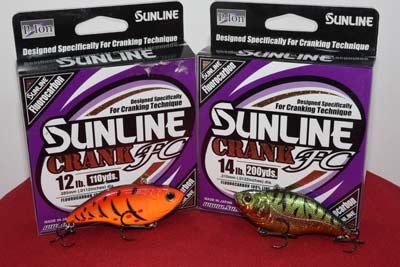
Traps are an excellent bait to cover water, look for bites, and locate bass in the process. Make your cast and try to hit the tops of the weeds you're fishing on the way back to the boat. When you hit the weeds, act like you're setting the hook, this many times will break the trap free and get it on its way again. When the bass sees the trap break free, you will get strikes most of the time.
If you have hard bottom areas outside of the weeds, these are also excellent areas to look at during the fall months. You will have to reposition your boat to be parallel with the weed edge in this case. Make a few casts to the tops of the weeds on edge. Then make a few casts down the weed edge, use a slower retrieve to get your trap deeper in the water column, and lastly, make a few other casts and let the trap sink to the bottom. Give the rod a good rip once you see your line go slack. This will jump your trap up off the bottom and let it settle back down again. Bass often pick up your trap as it's on the bottom or when the bait jumps off the bottom, so be ready.
I'm fishing a 7’ to 7’6” MH baitcaster teamed with a 6.3:1 reel filled with 15lb Sunline Assassin FC for this trap tactic. When it comes to the ripping tactic, I'll switch to a 7' MH rod teamed with a 6.3:1 baitcaster spooled with Sunline Xplasma Asegai 30lb braid with a 15lb FC leader. The biggest reason for this line switch is less stretch and better hooking power on a long cast. I have fished this tactic on fluorocarbon, and I would say that it was a 50/50 hookup ratio. So now I use braid for added hook-setting power.
Vibrating Jigs
Vibrating jigs are placed in between spinnerbaits and traps. When sitting down to draft this article and deciding baits to talk about, I crossed vibrating jigs off the list twice, but I always came back and said to myself that it was too important of a Fall bait to leave off the list. Easily the vibrating jig can stand on its own in this category by its own merits and should be on this list as it's one of my go-to’s during the fall transition time.
The key to generating more strikes with a vibrating jig is contacting the cover where the bass are holding. Are you starting to see the theme throughout this article? You will generate more bites if you get your baits to contact the cover holding bass.
Arm your vibrating jigs to match the forage in your waters to start. Shad, bluegill, and crawfish colors are top choices to start with but don't be afraid to throw straight white or chart/white combination colors either, as I have had many days that were all they wanted.
I'll either use a Big Bite Baits Swimon trailer or a swimbait as my trailer choices. I'll either match my trailer choice with the color of the skirt that I'm using, or if I'm fishing in stained or dirty water conditions, I will pick a trailer color that will make my bait stand out a little more. Chartreuse is a perfect color choice for these occasions.
Buzzbait/Frog
In certain parts of the country, frogs will start migrating back to the waters to hibernate for the winter months. At this time of the season, it's one of the best topwater bites of the season. Bass know and will be in the shallows looking for this to start happening. Now I'm cheating by adding two baits in this category, but they both belong to this tactic.
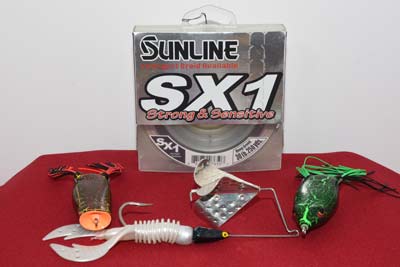
I'll start with a buzzbait because a buzzbait will let me cover water looking for signs of bass. If I get into an area where I generate a few strikes, I'll often slow down and grab a frog and work the area slower.
When it comes to equipment, I fish my buzzbait on braid these days for a couple of reasons. One is casting distance. I can cast farther with braided line than I can with FC. Less stretch is another key. I can get a good, solid hook set at the end of a long cast. And it floats; with the floating line, my buzzbait gets up on the surface with about one turn of the reel handle and get the bait coming in my direction. Last is dependability, I have lost numbers of bass with mono and fluorocarbon lines over the years, so many I lost track because the bass got me down in the weeds, and I could not turn them to come my way. I don't have that problem with braid. If I can get a hook into them, I can get them to the boat.
When it comes to a topwater frog, there is no better way to fish than to see your frog there for one twitch, and it's gone the next. I believe this is what bass fishing is built around the excitement that anglers get when a bass hits a topwater bait. There is not a better strike in fishing, hands down.
When you get into an area that you think holds bass slow down and work your frog up by the shore or cover that you think the bass are holding in. I have had many days that the bass will favor a frog over the buzzbait, and I feel this is just how fast each of them moves. Make sure that when you get in an area that you think is holding bass, take the extra time to use both baits before you move on. You may be a little surprised at how the bass may favor one over the other.
When it comes to frog choices, SPRO dominates this category. Stock the SPRO Bronzeye 65 Frog and the SPRO Popping Frog 60 in your tackle box.
Crankbaits
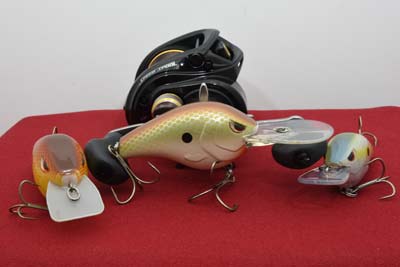
This may be a significant category to cover under one selection, so I'll break it up a little. First up are square bills. If you take a closer look at a square bill, it has the characteristics of a vibrating jig or trap. Make your cast and work the bait down when it hits the cover you're fishing. Give it a rip and get it on its way again. But there is one more thing that you can do before you get your bait moving, let it sit. If you do that with a trap or vibrating jig, the bait will fall back into the weeds and be harder to get out. With a square bill, you can rip the bait free and let it sit for a 1-1000, 2-1000 count before you get the bait back on its way again. When bass are on the sluggish side, this is needed to trigger strikes. I have had days when they won't touch a trap or vibrating jig but won't stay off a square bill.
As the bass get a little deeper on the weeds flats, I will often switch to a mid-depth running crankbait. This bait will stay in the strike zone longer to trigger more bites along the way. Once again, contacting the cover you're fishing will trigger more bites than a free-running bait, so keep that in mind.
Pick a deeper running crankbait for this job if you want to target the deeper bass on the outside edge. My number one choice is a Storm Mag Wart with a close second being a SPRO Fat Pappa. These baits complement each other as both baits have a wide wobble action that works through the weeds better than other crankbait out there.
Make your cast and start to work the bait down the edge of the weeds. When you contact the weeds, give the bait a rip like you're setting the hook. This will often break the bait free and on its way again. This breaking free action triggers strikes, so get ready for your rod to load up with a bass. One thing that I'll do is move up to a 7’6” or 7’10” MH cranking rod for this outside weedline tactic as I can get better results breaking the bait free and swimming again with the longer rod than a shorter cranking rod. I also get better hook setting power with this longer rod.
Jigs
The last category to cover is a jig. All the categories I have covered so far have been moving bait patterns. You can often take active bass with these presentations, but slow down and start to fish a jig if you want to trigger strikes from inactive bass.
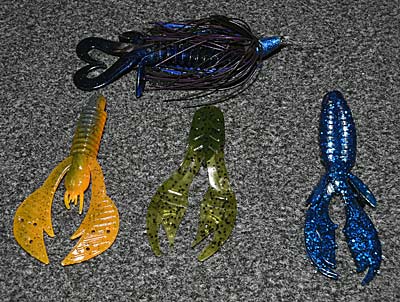
You have a surprisingly good idea of where the bass are holding now, so slow down and pick the area apart with a jig. I can't tell you how many times I have made a second pass through an area with a jig in my hand, taken a few more fish, and may I add these are the bigger bass in this area many times. As we all know, the bigger bass tend to hang back and only react to the prime bite opportunities. That is how they got to be to the stature they are at.
I'll also do to enhance my bites to upsize my bait trailer a little. Instead of using just a chunk as my trailer, I'll often use a 4” Big Bite YoMoma. This gives my jig a bigger profile and slows down the jig's fall rate. Keeping the jig in the strike zone a tad bit longer will often trigger reluctant bass to bite the jig. I also play to the bass’ goal of putting on weight for the upcoming change of season by showing them a bigger bait to trigger better bites.
I hope this breakdown of the Fall Six gives you some ammunition for when you hit the water next time and helps you get more bites this fall season. The key to finding bass in the fall is to cover water. When you get into an area holding fish, slow down and pick the area apart. Have a great fall fishing season.
BassResource may receive a portion of revenues if you purchase using a link above.


